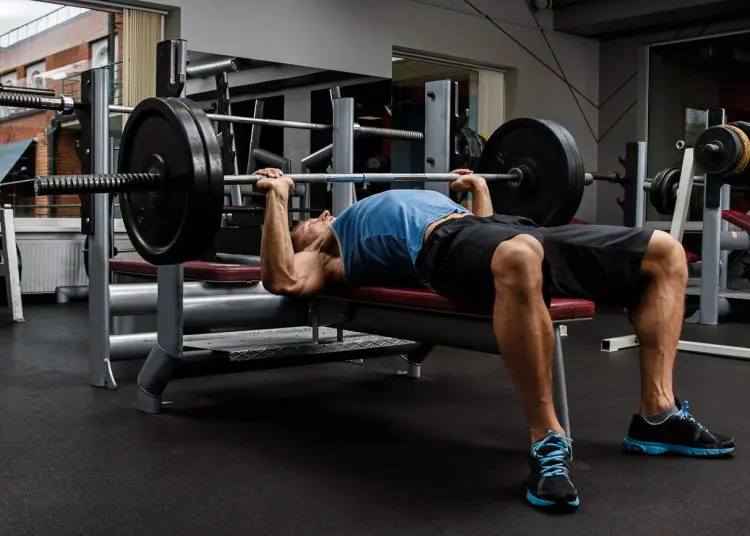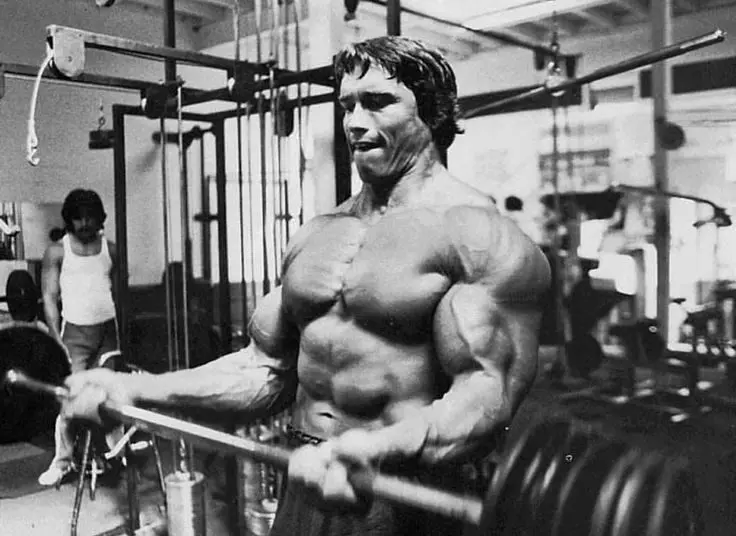Most bodybuilding and strength training workouts include anywhere between three and eight or more exercises. They’re often designed to hit your muscles from lots of different angles in an attempt to maximize hypertrophy or eliminate weak links.
While such an approach obviously works, it’s not the only way to get big and strong.
The One Lift A Day (OLAD) workout is the exact opposite of almost every other strength training program you’ve ever read about or followed, and that’s why it works.
By being so different, it’s a fantastic way to bust out of a training rut. It’s also very time-efficient and teaches you to focus on the best exercises for building muscle size and strength.
If you’ve had enough of long, convoluted workouts or just want to see how effective a minimalist approach to training can be, give the OLAD workout a try!
What Is the One Lift A Day Workout?
Level Up Your Fitness: Join our 💪 strong community in Fitness Volt Newsletter. Get daily inspiration, expert-backed workouts, nutrition tips, the latest in strength sports, and the support you need to reach your goals. Subscribe for free!
A lot of workouts have complicated or impenetrable names. They all but force you to study them to find out what’s involved. Take the PHAT Workout, for example; what the heck is that all about?!
The One Lift A Day workout is exactly what it sounds like – you do one exercise (lift) per training day. Your set and rep scheme should reflect your training goals but, every day you train, you just do one exercise and a different exercise each workout.
There are lots of ways to interpret the OLAD workout, but it works best when you follow a template like this:
- Monday – bench press variation, e.g., barbell bench press, incline bench press, dumbbell bench press, floor press
- Tuesday – row variation, e.g., bent-over row, Pendlay row, single-arm dumbbell row
- Wednesday – squat variation, e.g., back squat, front squat, box squat
- Thursday – rest
- Friday – overhead press variation, e.g., overhead barbell press, dumbbell overhead press, push press
- Saturday – deadlift variation, e.g., conventional deadlift, sumo deadlift, rack pull, deficit deadlift
- Sunday – rest
Providing you choose compound exercises, you should have no problem training every major muscle using the OLAD workout approach. Each day targets a whole bunch of large muscle groups, while smaller muscles like your biceps, triceps, and core are trained indirectly as synergists or helper muscles.
Ideally, you should pick and stick with the same exercises for 4-6 weeks to give the OLAD workout time to work its magic. After that, you can either swap exercises or move to a different training program. Simple!
Sets and Reps
Once you’ve chosen your exercises, you need to decide on your set and rep scheme. This should match your training goal, i.e.:
| Training Goal | Endurance | Hypertrophy | Strength/Power |
| Intensity | Low | Moderate | High |
| Load | <67% of 1RM | 67-85% of 1RM | >85% of 1RM |
| 1RM = 1-repetition maximum and is the maximum amount of weight that can be lifted once but not twice | |||
| Repetitions per set | 13-20 | 6-12 | 1-5 |
| Recovery between sets | 30-60 seconds | 1-2 minutes | 3-5 minutes+ |
However, rather than just fall into the trap of doing three sets of ten for hypertrophy or four sets of three for strength, try one of these tried and tested set and rep schemes to make your workouts more interesting and productive.
8 sets of 3 – load up the bar with your 5RM. 24 reps with your 5RM will increase strength and provide you with plenty of muscle-building volume too.
5 sets of 5 reps – a powerbuilding classic, 5 sets of 5 reps build strength and muscle size. Do all five sets with the same weight or ramp up to a final, max weight set as preferred.
4 sets of 8 reps – 8 rep sets build functional hypertrophy, which means your muscles will be as strong as they look. However, it’s a little more forgiving than 5 sets of 5, which can be brutally hard.
12, 10, 8, 6 rep pyramid – start light and increase the weight set by set.
6, 8, 10, 12 rep pyramid – start heavy and reduce the weight set by set.
15 sets of 1 rep EMOM – load up the bar with around 80% of your 1RM and do one rep every minute, on the minute, for 15 sets. Work up to 20, 30, and even 40 sets.
5 ladders – load up the bar with 60-80% of your 1RM. Do one rep, rest 5-10 seconds, do two reps, and rest again, and then do three reps. Keep adding a rep until you are unable to continue. Rest 2-3 minutes and repeat, starting back at one rep. Do five ladders in total.
50 reps – load up the bar with a weight you can lift 5-8 times. Do as many reps as you can, and then rest a minute or two. Do another set and rest again. Keep going until you complete 50 reps.
The Benefits of The OLAD Workout
The OLAD workout is very different from how most people train. However, this Spartan approach to exercise has several benefits and advantages:
Time efficiency – with just one exercise to warm up for, OLAD workouts are usually shorter than multi-exercise workouts. You could be in and out of the gym in 30 minutes or less, but 40 minutes is more typical.
It teaches you to focus on the best exercises – when you do a lot of exercises per muscle group, you’ll probably end up getting a semi-decent workout simply because of your training volume. After all, if you throw enough mud at a blanket, at least some of it will stick! Think of this as a scattergun approach to program design.
Level Up Your Fitness: Join our 💪 strong community in Fitness Volt Newsletter. Get daily inspiration, expert-backed workouts, nutrition tips, the latest in strength sports, and the support you need to reach your goals. Subscribe for free!
With OLAD, you have to choose one exercise per workout, so it had better be a good one. Using OLAD teaches you to recognize and pick the best exercise to work the target body part of the day.
Technical mastery – doing lots of sets and reps of just one exercise per workout means you’ll get better at it in double-quick time. Strength training staples like squats and bench presses are as much a skill as they are they are exercises. The more reps you do, the more practice you’ll get, and the more technically proficient you’ll become.
Perfect for home and garage trainers – you don’t need a whole lot of fancy equipment to do OLAD. In fact, a barbell and some weight plates should do it. If you train at home or in your garage, this could be the workout you’ve been waiting for.
No frills, no fuss – go hard, go heavy, go home! With OLAD, you can forget all about things like joint angles and hitting your upper this and lower that; just pick a compound exercise and work hard. A lot of people find such a simplistic approach to training very refreshing.
The Drawbacks of The OLAD Workout
OLAD works, but it’s not perfect. Like any workout, there are disadvantages too. The main drawbacks are:
Weak links – with no space for isolation or assistance exercises, you may find that your workout performance is limited by your weak kinetic links. For example, if you have weak triceps, your bench press may not be as strong as it should be, and your chest development is affected as a result.
Equipment hogging – doing OLAD in a commercial gym means monopolizing a single piece of equipment or training area for the duration of your workout. This may upset your fellow gym users.
Muscle imbalances – while the OLAD does work most of your major muscles and many minor ones too, some muscle groups won’t get a lot of stimulation. If you like to make sure every muscle receives equal attention, this is not the workout for you.
Fearfulness – let’s be honest, the idea of doing just one exercise per workout scares you a little, right? How can such a simple program work? The reality is that, so long as you work hard, such a sparse workout can produce great results, but you’ll have to shake off your reservations and try it for yourself to see.
Boredom – some exercisers may find doing one lift per workout and just five exercises per week boring. If you prefer a more varied approach to training, you probably won’t enjoy OLAD.
Shorter workouts – while short workouts can be an advantage, they can be a drawback too. If you like hitting the gym for 90 minutes at a time, finishing in 30-40 minutes may leave you feeling deprived.
One Lift A Day FAQs
The OLAD workout is so simple, but some people probably still have questions. If you are still unsure how to set up an OLAD workout plan, check out this FAQ.
1. Which exercises should I do?
Just pick one compound exercise per day. Choose an exercise you enjoy but that you also find challenging. Barbell exercises are usually best, but you could use dumbbells, or even bodyweight moves too. Choose the exercise that gives you the biggest bang for your buck. For example, deadlifts are an excellent choice, while something like 45-degree back extensions is not. Think BIG!
Stick with your chosen exercise for a month or so before switching to a different but similar movement, e.g., from front squats to back squats or flat bench press to inclines.
2. Can I do a second exercise?
Of course, you can, but then you’d no longer be doing the OLAD workout! That’s a bit like asking if you can ride your bike in a swimming race. OLAD means One Lift A Day, and not two. If you need to do things like pull-aparts for pre-hab, do them separate from your main workout.
3. How should I warm up?
The best way to warm up for heavy strength training is with ramped sets. For example, if you’re planning on doing five sets of five with 200 lbs, your warm-up might look something like this:
- 10 reps 45 lbs (empty barbell)
- 8 reps 90 lbs
- 5 reps 135 lbs
- 3 reps 175 lbs
- 5 reps 200 lbs (first work set)
You may also want to include some easy cardio, dynamic stretching, and joint mobility exercises in your warm-up.
4. What about cardio?
OLAD doesn’t have cardio in it, but that doesn’t mean you can’t add some. Do 20-30 minutes after your strength exercise or later in the day. Don’t do a ton of cardio before lifting, as it could tire you out and reduce your workout performance.
5. What should I eat with OLAD?
The aim of OLAD is to build size and strength, so you should probably have a calorie surplus to fuel your workouts and muscle repair and growth. OLAD is best used as a bulking workout rather than for fat loss.
6. Can I do more or fewer workouts?
Yes, you can. You could apply the rules of OLAD to three, four, or six workouts if you wish. However, doing fewer than five exercises means you may leave a muscle group or body part undertrained. But, if you can only get in the gym 3-4 times per week, you should still be able to make it work.
If you are able to train six times a week, adding a pulldown or pull-up workout could be very useful. Make sure you still have a rest day; it’s rarely beneficial to train seven days a week.
7. Can I change the order of the workouts?
Yes, but make sure you avoid doing similar exercises on consecutive days. For example, it would be a mistake to do bench presses on Monday and overhead presses on Tuesday. Similarly, squatting one day and deadlifting the next is not ideal either. Try to follow something like a push-pull-legs or upper body-lower body order so that you are well rested between workouts.
The One Lift A Day (OLAD) Workout – Wrapping Up
Weightlifter and powerlifters have used variations of the OLAD workout to achieve phenomenal levels of strength and size. Don’t let the simplicity of this workout fool you; it’s brutally effective. It strips away all the unnecessary exercises that can clutter up your workouts and forces you to focus on what’s really important – hard work!
It can be unnerving to head into the gym to do just one exercise, but it can be freeing too. Have faith in your exercise selection, and work that single exercise as if your life depends on it.
You don’t need exotic exercises and fancy equipment to get big and strong, although it’s clear that more extensive training programs work, too. But, if you want to get back to basics and embrace training minimalism, the OLAD workout is the way to do it.












